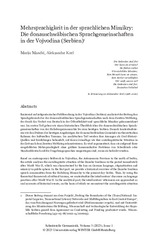Prikaz osnovnih podataka o dokumentu
Mehrsprachigkeit in der sprachlichen Mimikry: Die donauschwäbischen Sprachgemeinschaften in der Vojvodina (Serbien)
Multilingualism in language mimicry: The Danube Swabian language communities in Vojvodina (Serbia)
| dc.contributor | Mertins, Barbara (Hrsg.) | |
| dc.contributor | Leimbrink, Kerstin (Hrsg.) | |
| dc.contributor | Lipavic Oštir, Alja (Hrsg.) | |
| dc.creator | Mandić, Marija | |
| dc.creator | Krel, Aleksandar | |
| dc.date.accessioned | 2023-11-13T20:37:48Z | |
| dc.date.available | 2023-11-13T20:37:48Z | |
| dc.date.issued | 2023 | |
| dc.identifier.issn | 2748-369X | |
| dc.identifier.uri | http://rifdt.instifdt.bg.ac.rs/123456789/3215 | |
| dc.description.abstract | Basierend auf zeitgenössischer Feldforschung in der Vojvodina (Serbien) analysiert der Beitrag den Sprachgebrauch der der donauschwäbischen Sprachgemeinschaften nach dem Zweiten Weltkrieg, der durch das Verbot von Deutsch in der Öffentlichkeit und sprachliche Mimikry gekennzeichnet war. Im ersten Teil geben wir einen historischen Überblick über die Donauschwäbischen Sprachgemeinschaften von der Habsburgermonarchie bis zum heutigen Serbien. Danach kontextualisie ren wir den Diskurs der heutigen Angehörigen der donauschwäbischen Gemeinde im theoretischen Rahmen des kulturellen Traumas. Im analytischen Teil werden ihre Aussagen als Oral-History Quellen und Erzählungen behandelt, auf deren Grundlage wir ihre soziolinguistische Situation in der Zeit nach dem Zweiten Weltkrieg rekonstruieren. Es wird argumentiert, dass sie aufgrund ihrer ausgebildeten Mehrsprachigkeit ohne größere kommunikative Probleme von Schwäbisch oder Standarddeutsch auf die Umgebungssprachen umgestiegen sind, wenn sie bedroht wurden. | sr |
| dc.description.abstract | Based on contemporary fieldwork in Vojvodina, the Autonomous Province in the north of Serbia, the article analyses the sociolinguistic situation of the Danube Swabians in the period immediately after World War II, which was characterized by the ban on German language, stigmatization and mimicry in public sphere. In the first part, we provide a historical overview of the Danube Swabian speech communities from the Habsburg Monarchy to the present-day Serbia. Then, by using the theoretical framework of cultural trauma, we contextualize the interlocutors’ discourse on language practices after World War II. In the analytical part, the interlocutors’ utterances are approached as oral accounts of historical events, on the basis of which we reconstruct the sociolinguistic situation of the Danube Swabians. The article shows, on the one hand, that the practices of language mimicry and language shift were widespread, and, on the other hand, it sheds light on the role that multilingualism played in the language mimicry of the Danube Swabian speech communities. It is argued that the Danube Swabian speech communities, when threatened, switched from Swabian or standard German to languages of their social environment without major communicative problems due to their developed multilingualism. | sr |
| dc.language.iso | de | sr |
| dc.publisher | Heidelberg : Universitätsverlag Winter | sr |
| dc.relation | (Trans)National: Imperial Legacies, Transnational Literary Networks and Multilingualism in East Central Europe“, Research Council of Norway (Grant 275981 ) | sr |
| dc.relation | Ministry of Education, Science and Technological Development of the Republic of Serbia in accordance with the Agreement on Conducting and Funding. Scientific research (451-03-68/2022-14/200025 | sr |
| dc.rights | openAccess | sr |
| dc.rights.uri | https://creativecommons.org/licenses/by/4.0/ | |
| dc.source | Schnittstelle Germanistik. Forum für Deutsche Sprache, Literatur und Kultur des mittleren und östlichen Europas | sr |
| dc.subject | Donauschwaben | sr |
| dc.subject | Vojvodina | sr |
| dc.subject | Zweiter Weltkrieg | sr |
| dc.subject | kulturelles Trauma | sr |
| dc.subject | Diachrone Soziolinguistik | sr |
| dc.subject | Sprachmimikry | sr |
| dc.subject | Mehrsprachigkeit | sr |
| dc.subject | Danube Swabians | sr |
| dc.subject | Second World War | sr |
| dc.subject | cultural trauma | sr |
| dc.subject | diachronic sociolinguistics | sr |
| dc.subject | language mimicry | sr |
| dc.subject | multilingualism | sr |
| dc.title | Mehrsprachigkeit in der sprachlichen Mimikry: Die donauschwäbischen Sprachgemeinschaften in der Vojvodina (Serbien) | sr |
| dc.title | Multilingualism in language mimicry: The Danube Swabian language communities in Vojvodina (Serbia) | sr |
| dc.type | article | sr |
| dc.rights.license | BY | sr |
| dc.citation.issue | 1 | |
| dc.citation.volume | 3 | |
| dc.description.other | Thematische Ausgabe "Mehrsprachigkeit in deutschsprachigen Kontexten" | sr |
| dc.citation.spage | 67 | |
| dc.citation.epage | 93 | |
| dc.identifier.doi | 10.33675/SGER/2023/1/7 | |
| dc.type.version | publishedVersion | sr |
| dc.identifier.fulltext | http://rifdt.instifdt.bg.ac.rs/bitstream/id/10985/bitstream_10985.pdf |

